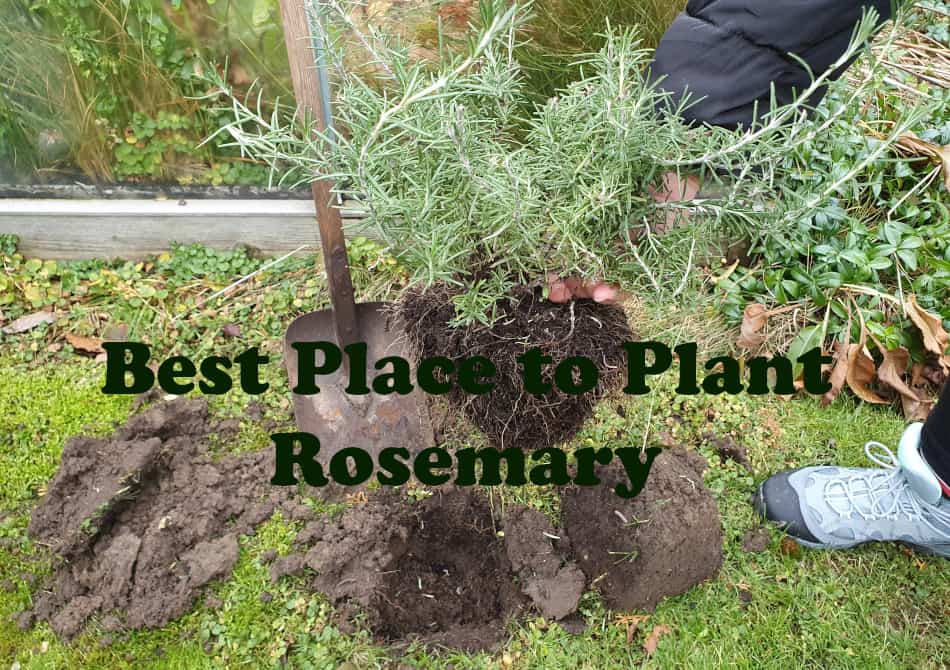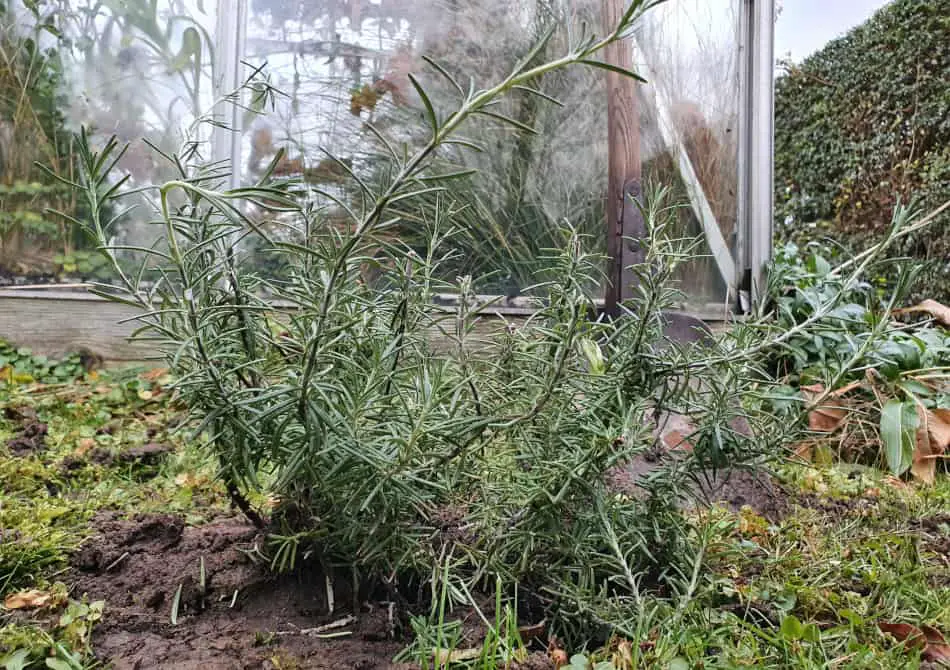I had to move one of my rosemary plants from a pot to the ground in the garden recently, and since I wasn’t sure what the best place to plant it was, I decided to reach out to an expert. She told me everything I needed to know (and then some) about finding the best place to plant rosemary. I have written this post to share what I learned.
The best place to plant rosemary is in sandy soil next to a south-facing wall if you live in the northern hemisphere and next to a north-facing wall if you live in the southern hemisphere. This allows the plants to get as much sunlight as possible while being shielded from the wind.
Before planting my rosemary, I made sure I understood how to find the best place where it can thrive for many years. Below, I summarize everything I learned, so you can also find the best place to plant your rosemary, whether you want it to grow directly in the ground or a pot, or indoors or outside.
Best Place to Plant Rosemary (6 Things to Keep In Mind)

One of my go-to strategies, when I have gardening-related questions that I can’t easily find the answer to online, is to call one of the garden centers near where I live. They have a phone number only for gardening advice, and they have some highly knowledgeable gardeners answering the phone. I have yet to ask them something they didn’t know at least a bit about.
Finding the best place to plant rosemary happened to be something Camilla, the person I spoke to from the garden center, knew a lot about. She highlighted six key factors to consider when deciding where to plant rosemary.
Below, I explain why each of the six factors are important when finding the best place to plant your rosemary and how you can easily identify it in your garden, but if you just want a quick summary, here you go:
- Sunlight: The more the better. At least 6-8 hours of sunlight per day in the summer.
- Wind: Plant your rosemary in a place where it is shielded from wind.
- Soil: Rosemary prefers sandy soil or loam.
- Spacing: Plant rosemary plants 2-3 feet (about 60-90 cm) apart.
- Pot vs. ground: Rosemary grows best in the ground, but can grow just fine in a big pot (at least 12 inches/60 cm height and width)
- Indoors vs. outside: Rosemary grows best outside, but can grow just fine indoors if given enough sunlight.
Conclusion: Planting your rosemary in sandy soil next to a south-facing wall (or north-facing if you live in the southern hemisphere) provides the plant with the best conditions to grow and thrive for many years, as it can get enough sun while being protected from the wind.
Another thing that is important when putting rosemary in your garden is knowing the best time to do so. I have written another post to help you determine that.
Below, I explain what Camilla, the gardener I spoke to from the garden center, said about why each of the six factors are important.
Direct Sunlight
Rosemary is a native to the Mediterranean region, so it is naturally adjusted to require and thrive with a lot of sunlight.
Here is what the gardener I spoke to said about rosemary and sunlight:
The more sunlight rosemary gets, the better. Rosemary should get at least 6-8 hours of sunlight per day in the summer and as much as possible during the rest of the year. Rosemary essentially can’t get too much sunlight.
This is perhaps the most important thing to consider when planting your rosemary, so find a place that gets plenty of sunlight.
I have included the most important information about rosemary and sunlight here, but if you are curious and want to know more about that and all the other growing conditions that make rosemary healthy such as watering, fertilizing, and more, you can read about that on this link.
As I mentioned earlier in this post, it is best to plant rosemary up against a south-facing wall (or north-facing for those of you in the southern hemisphere). That allows the plant to get a lot of sunlight while also being shielded from the wind, which is the next point.
If you aren’t sure which way south is, many phones these days have a built-in compass, but Google Maps also works really well. That’s what I usually use when I need to know.
If you plan to grow rosemary in a pot, you can easily move the plant around whenever necessary. It can be a good idea to move it a few times throughout the year, as the direction the sunlight comes from changes.
Wind
Rosemary grows best when it is shielded from the wind. It doesn’t have to be completely shielded from all directions, but the more the better as long as the plant is still getting enough sunlight.
When talking about this, Camilla, the expert I spoke to, repeated her previous recommendation of planting rosemary up against a wall where it can get plenty of sunlight.
Type of Soil
The type of soil you use can affect how well rosemary grows a lot. Rosemary plants have a relatively large and complex root system, so they need the correct soil type to be as healthy as possible.
The best type of soil for rosemary to grow in is soil with high sand content. If the soil in your garden has a lot of clay and no sand, it is a good idea to dig a larger hole than you need, pour sand in, and mix it with the soil to create soil that contains about 40-50% sand.
Rosemary does not grow very well in regular potting soil either.
Another important factor when it comes to the soil you grow rosemary in is the drainage, but if the soil contains a lot of sand, the drainage will usually be fine. If you grow rosemary in a pot, it must have one or more holes for drainage to avoid potential problems such as overwatering.
When I did some research about the best type of soil to plant rosemary in, I found an excellent study from the National Research Centre in Egypt and the Faculty of Agriculture and Natural Resources at Aswan University, also in Egypt, about how soil type affects growth and productivity in rosemary. You can find the paper about the study on this link.
The study’s conclusion fits very well with what Camilla, the gardener I spoke to on the phone before I moved my own rosemary to the garden, said. It said that rosemary grew best in loam, which is a soil type with high sand content.
In fact, not only does the sandy soil type increase growth and productivity, but also the contents of essential oils in rosemary, according to the study.
Spacing
Rosemary plants can live for many years and get pretty big, so to avoid problems in the future, you should give your plants plenty of space.
When planting rosemary, make sure there are 2-3 feet of spacing between the plant and any other plant.
I am guilty of underestimating how much space plants need more than once. When growing rosemary in a pot, this is easy to manage as you can just move it around, but it is really good to consider this from the beginning when growing it in the ground.
I have written another article where I explain just how large rosemary can get as well as how you can help it get as large as possible or keep it small depending on what you prefer.
Pot vs. ground
Rosemary plants can grow pretty large and complex root systems as they become older and more prominent, so naturally, they need room for that.
As a general rule, rosemary grows better in the ground than in a pot since its roots have more room to grow and spread. Large pots can also be used to grow rosemary and will work just fine, but avoid pots smaller than 12 inches (30 cm) in depth and diameter.
There are also some advantages to growing rosemary in a pot instead of the ground. For instance, it is much easier to control watering, and the ability to move the plant around if needed can be really useful. I have written another post where I cover some good things to be aware of when choosing between a pot and the ground for growing rosemary.
Indoors vs. Outside
Rosemary grows better outside than indoors. There isn’t much getting around that, so if you want to grow rosemary outside, that is good news, but if you want to grow it indoors, that can also work just fine, but you need to find a spot where it can get as much sun as possible.
You can read a lot more about the difference between growing rosemary indoors and outside here.
Other than the six factors covered above, a thing that can affect how well rosemary grows and should be considered when choosing where to plant it is what plants are growing near it. So I get into that below and give five examples of plants rosemary thrives near and five plants you should not plant rosemary next to.
Keep in mind that while companion planting is fun to play around with, it can seem too advanced for many people (it certainly was for me for a good while) and if you don’t want to think about that now, it’s totally fine. Just get started and plant your rosemary. That is, after all, the most important step.
5 Plants Rosemary Grows Well Near (And 4 Plants to Avoid)

Certain plants grow much better next to each other than other plants. This is called companion planting, and what determines which plants grow well next to each other and which don’t is usually how the plants affect the soil around them, what bugs they attract, and what kinds of pests they repel.
If you use companion planting correctly, you can essentially create a tiny ecosystem where all the plants support each other by promoting growth and repelling pests for each other.
Here is a table with five great companion plants for rosemary and four plants you should not plant rosemary next to.
| Plants that are good to plant rosemary next to | Plants you should not plant rosemary next to |
| Onions | Cucumbers |
| Beans | Potatoes |
| Sage | Pumpkins |
| Broccoli | Tomatoes |
| Parsnips |
Companion planting can be fun to play around with, but if it is too advanced to think about at this point, don’t worry too much about it. Just make sure there is plenty of spacing, ideally at least 2-3 feet (about 60-90 cm) between your rosemary plant and any other plant.

